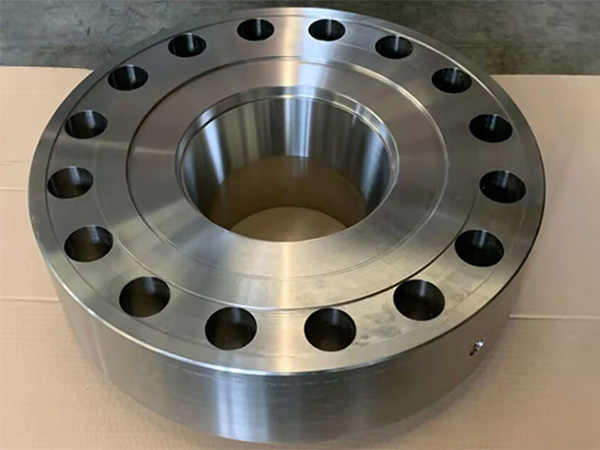Stainless Steel Pipe flanges are important components for connecting pipes, valves, pumps and other equipment, and are widely used in industries such as petroleum, natural gas, chemical engineering, power, shipbuilding and water treatment. They not only provide reliable sealed connections, but also facilitate the disassembly, inspection and maintenance of the system.
Common types and applications
According to structure and connection methods,
stainless steel pipe flanges mainly have the following types, each of which is suitable for specific working conditions:
Butt-weld flange: It features a long conical neck and is connected to the pipe by butt welding. The weld seam has high strength and can effectively disperse stress. It is usually used in high-pressure, high-temperature or low-temperature environments, such as the petroleum, natural gas, chemical, power and other industries.

Flat welding flange: The inner diameter is slightly larger than the outer diameter of the pipe. After being placed on the pipe, double-sided fillet welding is carried out. It is easy to install and has a relatively low cost. It is applicable to medium and low pressure systems, such as water treatment, HVAC, fire protection pipelines, etc.
Threaded flange: It is connected to the pipe through internal threads and external threads without the need for welding, making it easy to disassemble. It is suitable for low-pressure, small-diameter systems, or situations where welding is not appropriate, such as gas and compressed air pipelines, etc.
Socket welding flange: After inserting the pipe into the inner hole of the flange, fillet welding is carried out. It is suitable for small-diameter and high-pressure systems and has high welding strength. It is applicable to high-pressure and small-diameter pipelines, such as in the chemical and petrochemical industries.
Loose flange: Usually used in conjunction with short sections, the flange can rotate freely, facilitating alignment with bolt holes, and is suitable for systems that require frequent disassembly. It is suitable for pipeline systems that need to be frequently disassembled or cleaned, such as in the food, pharmaceutical, water treatment and other industries.
Common materials and properties
The material selection of stainless steel flanges should be comprehensively considered based on factors such as the corrosiveness of the usage environment, working pressure and temperature. Common materials include:
304/304L: General-purpose stainless steel with good corrosion resistance, suitable for most neutral environments.
316/316L: Containing molybdenum, it has stronger corrosion resistance and is suitable for environments with strong corrosiveness such as Marine and chemical industries.
321: With the addition of titanium, it has excellent resistance to intergranular corrosion and is suitable for high-temperature environments.
347: Niobium is added to enhance high-temperature oxidation resistance, making it suitable for high-temperature and high-pressure environments.
904L: High-alloy austenitic stainless steel, resistant to strong corrosive media, suitable for strong acid environments.
Duplex stainless steel (such as 2205, 2507) : It features a duplex structure of austenite and ferrite, with high strength and excellent corrosion resistance, making it suitable for high-strength and highly corrosive environments.
Common standards and norms
The design, manufacture and inspection of stainless steel flanges must comply with the corresponding international or national standards to ensure their performance and interchangeability. Common standards include:
ASME (American Society of Mechanical Engineers) standards:
ASME B16.5: Applicable to flanges with nominal dimensions ranging from 1/2" to 24", covering pressure classes from Class 150 to 2500.
ASME B16.47: Applicable to large-diameter flanges and divided into Series A and Series B.
DIN (German Industrial Standard) :
Such as DIN 2633, DIN 2576, etc., which are applicable to flanges of different pressure grades and connection methods.
EN (European Standard) :
EN 1092-1: It covers various types of flanges and is widely used in the European region.
GB (Chinese National Standard) :
GB/T 9112-9123: Applicable to various types of flange connections.
JIS (Japanese Industrial Standard) :
JIS B2220: Covers flanges of different pressure grades and types.
The installation and disassembly methods of common stainless steel flange types
Flanges to be welded
Installation steps:
Clean the flange and the end face of the pipe to ensure there is no oil stain, rust or impurities.
Put the flange on the pipe and adjust it to the appropriate position.
Carry out butt welding, and the weld seam should comply with relevant welding specifications to ensure welding quality.
Non-destructive testing is carried out after welding to ensure that there are no defects in the weld seam.
Install the gasket, align it with the butt flange, insert the bolts and tighten them evenly diagonally.
Disassembly instructions:
Since the flange is connected to the pipe by welding, it cannot be disassembled directly. If replacement is needed, the weld seam needs to be cut and the flange removed. The operation is complex and costly.
Flange that does not require welding
Installation steps:
Clean the flange and the end face of the pipe.
Align the blind plate flange with the butt flange and insert the gasket.
Insert the bolts and tighten them evenly diagonally.
Disassembly steps: Loosen the bolts, remove the flange and gasket. The operation is simple and convenient.
In conclusion, stainless steel pipe flanges are an important component of pipe connections. They are suitable for industrial applications of various sizes, shapes and types.
